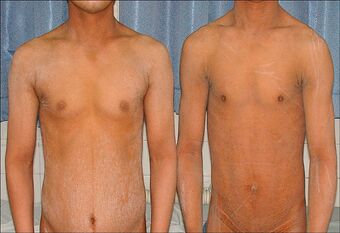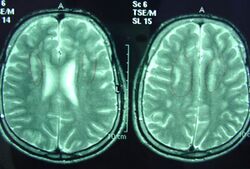Medicine:Sjögren–Larsson syndrome
Sjögren–Larsson syndrome is a rare autosomal recessive form of ichthyosis with neurological symptoms.[1]:485[2]:564[3] It can be identified by a triad of medical disorders. The first is ichthyosis, which is a buildup of skin to form a scale-like covering that causes dry skin and other problems. The second identifier is paraplegia which is characterized by leg spasms. The final identifier is intellectual delay.
SLS is caused by a mutation in the fatty aldehyde dehydrogenase gene found on chromosome 17.[4] In order for a child to receive SLS both parents must be carriers of the SLS gene. If they are carriers their child has a 1⁄4 chance of getting the disease. In 1957 Sjögren and Larsson proposed that the Swedes with the disease all descended from a common ancestor 600 years ago. Today only 30–40 persons in Sweden have this disease.[5]
Signs and symptoms
- Dry and scaly skin similar to all other ichtyosiforms (types of ichthyosis).
- Neurological problems – this can often cause mild paralysis in the legs
- Mild to moderate intellectual disability.
- Often associated ocular features, which include pigmentary changes in the retina.
The usual presentation of crystalline maculopathy is from the age of 1–2 years onwards.[citation needed]
Causes
It is associated with a deficiency of the enzyme fatty aldehyde dehydrogenase (ALDH3A2) which is encoded on the short arm of chromosome 17 (17p11.2). At least 11 distinct mutations have been identified.[6]
Without a functioning fatty aldehyde dehydrogenase enzyme, the body is unable to break down medium- and long-chain fatty aldehydes which then build up in the membranes of the skin and brain.[4]
This condition is inherited in an autosomal recessive pattern.[7]
Diagnosis
Diagnosis is made with a blood test which sees if the activity of the fatty aldehyde dehydrogenase enzyme is normal.[4] Gene sequencing can also be used, which can additionally be used by would-be parents to see if they are carriers.[4]
Treatment
The ichthyosis is usually treated with topical ointment.[4] Anti-convulsants are used to treat seizures[4] and the spasms may be improved with surgery.[4]
Eponym
It was characterized by Torsten Sjögren and Tage Konrad Leopold Larsson (1905–1998), a Swedish medical statistician.[8][9] It should not be confused with Sjögren's syndrome, which is a distinct condition named after a different person, Henrik Sjögren.[citation needed]
See also
- Shabbir syndrome
- List of cutaneous conditions
References
- ↑ Freedberg, et al. (2003). Fitzpatrick's Dermatology in General Medicine. (6th ed.). McGraw-Hill. ISBN:0-07-138076-0.
- ↑ James, William; Berger, Timothy; Elston, Dirk (2005). Andrews' Diseases of the Skin: Clinical Dermatology. (10th ed.). Saunders. ISBN:0-7216-2921-0.
- ↑ Rapini, Ronald P.; Bolognia, Jean L.; Jorizzo, Joseph L. (2007). Dermatology: 2-Volume Set. St. Louis: Mosby. ISBN 978-1-4160-2999-1.
- ↑ 4.0 4.1 4.2 4.3 4.4 4.5 4.6 "Sjogren-Larsson syndrome | Genetic and Rare Diseases Information Center (GARD) – an NCATS Program". https://rarediseases.info.nih.gov/diseases/7654/sjogren-larsson-syndrome.
- ↑ "Sjögren-Larssons syndrom". http://www.socialstyrelsen.se/ovanligadiagnoser/sjogren-larssonssyndrom.
- ↑ "Spectrum of mutations and sequence variants in the FALDH gene in patients with Sjögren–Larsson syndrome". Hum. Mutat. 12 (6): 377–84. 1998. doi:10.1002/(SICI)1098-1004(1998)12:6<377::AID-HUMU3>3.0.CO;2-I. PMID 9829906.
- ↑ Orphanet: Portal de enfermedades raras y medicamentos huérfanos
- ↑ synd/1678 at Who Named It?
- ↑ "Oligophrenia in combination with congenital ichthyosis and spastic disorders; a clinical and genetic study". Acta Psychiatr Neurol Scand Suppl 113: 1–112. 1957. PMID 13457946.
Further reading
- Sjögren, K. G. Torsten; Larsson, Tage K. (1957). "Oligophrenia in combination with congenital ichtyosis and spastic disorders; a clinical and genetic study". Acta Psychiatrica Scandinavica (Copenhagen) 32 (supplement 113): 9–105. doi:10.1111/j.1600-0447.1956.tb04725.x. PMID 13457946.
External links
| Classification | |
|---|---|
| External resources |
 |



